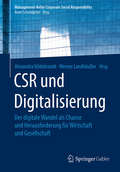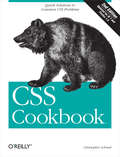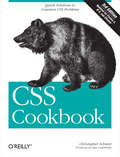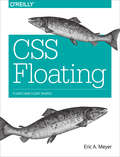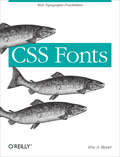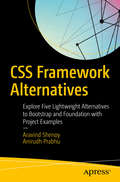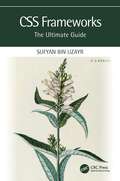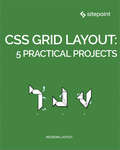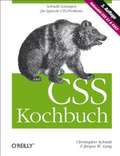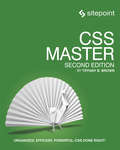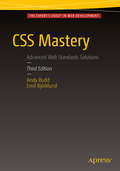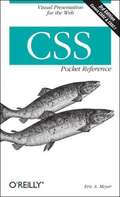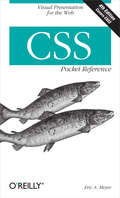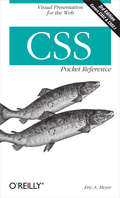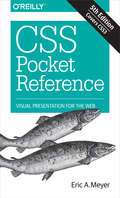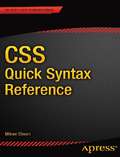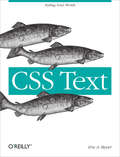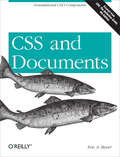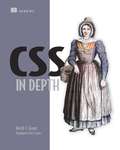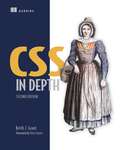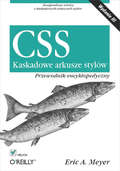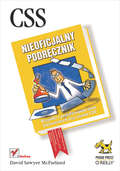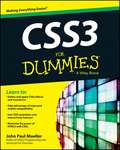- Table View
- List View
CSR und Digitalisierung: Der digitale Wandel als Chance und Herausforderung für Wirtschaft und Gesellschaft (Management-Reihe Corporate Social Responsibility)
by Alexandra Hildebrandt Werner LandhäußerDieses Buch ist ein Kaleidoskop unserer Gesellschaft und Zeit. Es besch#65533;ftigt sich mit Herausforderungen, Chancen und Risiken der gr#65533;#65533;ten Transformation der Geschichte: der Digitalisierung. Vorgestellt werden bahnbrechende neue Methoden zur nachhaltigen Steuerung der digitalen Transformation, neue Denkstile sowie neue Formen interdisziplin#65533;rer Zusammenarbeit - etwa mit Geistes-, Sozial- und Naturwissenschaftlern, #65533;konomen, Informatikern, Psychologen, Philosophen und Vertretern der Kreativwirtschaft. Sie zeigen, dass Digitalisierung weder gef#65533;rchtet noch verehrt werden muss, denn es geht vor allem darum, ihre Rolle zu verstehen, um sie nachhaltig zu gestalten.
CSR und Digitalisierung: Der digitale Wandel als Chance und Herausforderung für Wirtschaft und Gesellschaft (Management-Reihe Corporate Social Responsibility)
by Alexandra Hildebrandt Werner LandhäußerIn der 2. Auflage des Buches "CSR und Digitalisierung" werden zwei Jahrhundertthemen zusammengeführt, die die wichtigsten Fragen unserer Zeit bündelnWie können wir ökologisch und sozial verantwortlich wirtschaften?Welche Rolle kann und soll die Digitalisierung dabei spielen? Die Digitalagenda ist die erste Strategie in Europa, die Digitalisierung und Umweltschutz konsequent miteinander verbindetDas vorliegende Buch ist allerdings auch eine Erweiterung der hier angesprochenen Themen, denn viele der vorgeschlagenen Maßnahmen basieren auf „weichen“ Instrumenten. Gezeigt wird u. a., welche aktuellen Maßnahmen und Methoden zur nachhaltigen Steuerung der digitalen Transformation die besten Unternehmen und Organisationen einsetzen, aber auch, dass es heute neue Denkstile sowie neue Formen interdisziplinärer Zusammenarbeit braucht. Digitalisierung muss weder gefürchtet noch verehrt werden, denn es geht vor allem darum, ihre Rolle zu verstehen, um sie nachhaltig zu gestalten. Finden Sie Beiträge unter anderem von:Franz Alt, Wolfgang Schäuble, Judith Gerlach, Timotheus Höttges, Olaf Koch, Henning Kagermannm, Christian Seifert, Manuel Neukirchner, Jutta Rump
CSS Cookbook
by Christopher SchmittAs the industry standard method for enriching the presentation of HTML-based web pages, Cascading Style Sheets (CSS) allow you to give web pages more structure and a more sophisticated look. But first, you have to get past CSS theory and resolve real-world problems. For those all-too-common dilemmas that crop up with each project, CSS Cookbook provides hundreds of practical examples with CSS code recipes that you can use immediately to format your web pages. Arranged in a quick-lookup format for easy reference, the second edition has been updated to explain the unique behavior of the latest browsers: Microsoft's IE 7 and Mozilla's Firefox 1.5. Also, the book has been expanded to cover the interaction of CSS and images and now includes more recipes for beginning CSS users. The explanation that accompanies each recipe enables you to customize the formatting for your specific needs. With topics that range from basic web typography and page layout to techniques for formatting lists, forms, and tables, this book is a must-have companion, regardless of your experience with Cascading Style Sheets.
CSS Cookbook: Quick Solutions to Common CSS Problems (Animal Guide)
by Christopher SchmittLearn how to solve the real problems you face with CSS. This cookbook offers hundreds of practical examples for using CSS to format your web pages, and includes code samples you can use right away. You'll find exactly what you need, from the basics to complex hacks and workarounds.Each recipe explains how to customize a solution to meet your needs, and each chapter features a sample design that showcases the topics discussed. You'll learn about the behavior of the latest browsers-including IE 8, Firefox 3, Safari 4, and Google Chrome—and how you can resolve differences in the ways they display your web pages. Arranged in a convenient format for quick reference, this third edition is a valuable companion for anyone working with CSS.Learn the basics, such as the CSS rule structureWork with web typography and page layoutCreate effects for images and other page elementsLearn techniques for configuring lists, forms, and tablesDesign effective web navigation and create custom linksGet creative by combining CSS with JavaScriptLearn useful troubleshooting techniquesExplore features of HTML5 and CSS3
CSS Floating: Floats and Float Shapes
by Eric A. MeyerWhile flowing text around images is certainly nothing new, with CSS you can float any element, from images to paragraphs to lists. In this practical guide, author Eric Meyer reveals some interesting—and surprising—ways to use CSS floats in your web design, including the latest capability to flow content past non-rectangular float shapes.Short and sweet, this book is an excerpt from the upcoming fourth edition of CSS: The Definitive Guide. When you purchase either the print or the ebook edition of CSS Floating, you’ll receive a discount on the entire Definitive Guide once it’s released. Why wait? Learn how to bring life to your web pages now.Learn the characteristics of floated elements, and CSS rules for using themBe aware of certain rule exceptions when applying floats to your design, including the use of negative marginsUse the clear property to prevent floats from affecting elements in the next section of the documentCreate floating boxes in non-rectangular shapes, including rounded corners, circles, ellipses, and even polygonsDefine float shapes with transparent or opaque images
CSS Fonts: Web Typography Possibilities
by Eric A. MeyerFrom custom fonts to ad-hoc font families you assemble out of a variety of individual faces, CSS 3 gives you more typographic options than ever before. This concise guide shows you how to use CSS properties to gain a fine-grained and wide-ranging influence over how you display fonts on the Web.Short and sweet, this book is an excerpt from the upcoming fourth edition of CSS: The Definitive Guide. When you purchase either the print or the ebook edition of Fonts, you’ll receive a discount on the entire Definitive Guide once it’s released. Why wait? Learn how to choose and manipulate fonts right away.Specify font families and their generic alternativesUse @font-face to specify customized downloadable fontsSize your fonts with absolute or relative scales, percentages, or length unitsUnderstand the difference between italic and oblique stylesLearn how to specify or suppress a font’s kerning data and other font featuresSynthesize your own variants for fonts that lack bold or italic text
CSS Framework Alternatives: Explore Five Lightweight Alternatives To Bootstrap And Foundation With Project Examples
by Aravind Shenoy Anirudh PrabhuLearn how to use lightweight CSS framework alternatives to build intuitive websites. This book presents five project examples that use Skeleton, Miligram, UI Kit, Material Design Lite and Susy. This no-nonsense introduction will help you understand the concept of designing interactive websites using these frameworks with ease. Each framework is demonstrated through a practical project in an easy-to-understand manner. Web design is streamlined nowadays thanks to CSS frameworks and, although Bootstrap and Foundation rule the roost with web design, you don't need an exhaustive framework like these for smaller websites.You'll get a glimpse into additional front-end frameworks which basically are pre-prepared packages containing structure of files and folders of HTML and CSS documents (some with JavaScript functions) that help designers and developers build interactive and immersive websites. What You'll LearnDelve deeper into the world of CSS designs Create interactive and immersive webpages with UI Kit, Material Design Life, and SusyBuild a landing webpage with Skeleton Design a product page for a Secure VPN product with Milligram Who This Book Is ForReaders who are familiar with basic knowledge of HTML, CSS, and JavaScript, and experienced web designers who aren’t familiar with frameworks other than Bootstrap or Foundation.
CSS Frameworks: The Ultimate Guide (The Ultimate Guide)
by Sufyan bin UzayrCascading Style Sheets (CSS) is a programming language that integrates all relevant information related to the display of a web page. CSS defines the style and format of a web page or page, including layout, colors, fonts, & (the space around each element), and more. Together with HTML and JavaScript, CSS forms the basis of the functioning of the Internet. CSS Frameworks: The Ultimate Guide discusses the fundamental concepts of CSS that will help developers and coders do more with CSS Frameworks. This book is for anyone who wants to create a website and write optimized and well-structured code in CSS. It follows a hands-on approach and offers practical lessons and tutorials related to CSS Frameworks. Features: • Provides a detailed focus on CSS programming • Introduces CSS Frameworks using real-world industry concepts • Discusses optimization and maintenance of code in CSS Frameworks This book is a valuable resource for developers already familiar with HTML, and who have an understanding of JavaScript. After finishing this book, anyone will quickly build their website with absolute ease.
CSS Grid Layout: 5 Practical Projects
by Ahmed Bouchefra Craig Buckler Ilya Bodrov-Krukowski Giulio Mainardi Diego SouzaCSS has grown from a language for formatting documents into a robust language for designing web applications. Its syntax is easy to learn, making CSS a great entry point for those new to programming. Indeed, it's often the second language that developers learn, right behind HTML. One of CSS's new features is the Grid Layout Module, which enables complex layout designs that previously would have been very difficult to achieve. In this book, we'll examine five projects that use grid layout. It contains: Redesigning a Site to Use CSS Grid Layout by Ilya BodrovRedesigning a Card-based Tumblr Layout with CSS Grid by Giulio MainardiEasy and Responsive Modern CSS Grid Layout by Ahmed BouchefraProgressively Enhanced CSS Layouts from Floats to Flexbox to Grid by Diogo SouzaMake Forms Great with CSS Grid by Craig Buckler This book is suitable for developers with some CSS experience.
CSS Kochbuch
by Christopher Schmitt Joergen LangCascading Style Sheets (CSS) bieten unendliche Möglichkeiten, das Design einer Website gezielt und individuell zu gestalten. Mit CSS3 sind noch einmal viele Features hinzugekommen, auf die viele Designer schon lange gewartet haben: ob Schattenwürfe, abgerundete Ecken oder die Einbindung von Webfonts - ein genauer Blick auf die neuen Gestaltungsmöglichkeiten lohnt sich. Diese dritte Auflage des CSS Kochbuchs wurde grundlegend überarbeitet, aktualisiert und erweitert. In mehr als 200 Rezepten finden Sie Antworten auf gängige bis vertrackte Problemstellungen, denen Webdesigner immer wieder begegnen. CSS-Grundlagen: Der erste Teil des Buchs beschäftigt sich mit grundlegenden CSS-Techniken. Hier erfahren Sie Wissenswertes über die Auswahl und Gestaltung von Seitenelementen und erhalten Tipps rund um die Typografie fürs Web. Natürlich wird auch der Umgang mit Bildern behandelt. Fortgeschrittenere Techniken: Erfahren Sie, wie Sie Formulare, Tabellen und Listen gestalten und ins Layout Ihrer Seite einbetten. Lernen Sie, wie Sie Links und Navigationen optimal gestalten und Effekte wie Rollover, aufklappbare Menüs oder Tooltips mit CSS erzeugen. Seitenlayout und Design: Mit CSS lassen sich ein-, zwei und mehrspaltige Layouts umsetzen, die Sie wahlweise mit festen oder flexiblen Breiten versehen können. Dank der CSS3-Media Queries können Sie nun auch einfach feststellen, ob mit einem Desktop-Rechner, Smartphone oder Tablet auf Ihre Site zugegriffen wird und deren Ausgabe genau für das entsprechende Gerät optimieren. CSS 2.1 und CSS3: CSS3 ist noch relativ jung und wird nicht von allen Browsern gleich gut unterstützt. Dem trägt das Kochbuch Rechnung, indem CSS3-basierte Lösungen angeboten werden, wenn die Browserunterstützung schon sehr breit ist. Alle anderen Rezepte des Buchs basieren auf CSS 2.1.
CSS Master
by Tiffany B BrownCSS Master is tailor-made for the web designer or front-end devleoper who's really serious about taking their skills to the next level. Discover how to keep ahead of the game by adhering to best practice and employing the most effective, cutting-edge CSS techniques. Now thoroughly updated in its second edition, this book covers how to: Organize your CSS to create the most efficient and most maintainable codeEmploy advanced approaches to achieve complex layouts: flexbox, grid layouts, multi-column, and moreUse next-level effects: transitions, transforms, filters, animations, and moreCombine CSS and SVG to create seriously powerful visualsUse efficient debugging techniquesAnd much more!
CSS Mastery: Advanced Web Standards Solutions (Friends Of Ed Ser.)
by Andy Budd Emil BjörklundThis book is your indispensable guide to cutting-edge CSS development--all you need to work your way up to CSS professional. While CSS is a relatively simple technology to learn, it is a difficult one to master. When you first start developing sites using CSS, you will come across all kinds of infuriating browser bugs and inconsistencies. It sometimes feels like there are a million and one different techniques to master, spread across a bewildering array of websites. The range of possibilities seems endless and makes for a steep and daunting learning curve. By bringing all of the latest tips, tricks, and techniques together in one handy reference, this book demystifies the secrets of CSS and makes the journey to CSS mastery as simple and painless as possible. While most books concentrate on basic skills, this one is different, assuming that you already know the basics and why you should be using CSS in your work, and concentrating mainly on advanced techniques. It begins with a brief recap of CSS fundamentals such as the importance of meaningful markup, how to structure and maintain your code, and how the CSS layout model really works. With the basics out of the way, each subsequent chapter details a particular aspect of CSS-based design. Through a series of easy-to-follow tutorials, you will learn practical CSS techniques you can immediately start using in your daily work. Browser inconsistencies are the thorn in most CSS developers' sides, so we have dedicated two whole chapters to CSS hacks, filters, and bug fixing, as well as looking at image replacement; professional link, form, and list styling; pure CSS layouts; and much more. All of these techniques are then put into practice in two beautifully designed case studies, written by two of the world's best CSS designers, Simon Collison and Cameron Moll.
CSS Pocket Reference, 3rd Edition
by Eric MeyerThey say that good things come in small packages, and it's certainly true for this edition of CSS Pocket Reference . Completely revised and updated to reflect the latest Cascading Style Sheet specifications in CSS 2.1, this indispensable little book covers the most essential information that web designers and developers need to implement CSS effectively across all browsers. Inside, you'll find: A short introduction to the key concepts of CSS A complete alphabetical reference to all CSS 2.1 selectors and properties A chart displaying detailed information about CSS support for every style element and its cross-browser compatibility This reference neatly condenses the details of its top-selling companion volume, Cascading Style Sheets: The Definitive Guide into one easy-to-use cheat-sheet that delivers all the CSS details you need to complete the task at hand. Whenever you're stuck and need an answer quickly -- or if you just want to be sure you're applying CSS correctly -- this edition of the CSS Pocket Reference is the book you'll want by your keyboard or, conveniently, in your back pocket.
CSS Pocket Reference: Visual Presentation for the Web
by Eric A. MeyerWhen you're working with CSS and need a quick answer, CSS Pocket Reference delivers. This handy, concise book provides all of the essential information you need to implement CSS on the fly. Ideal for intermediate to advanced web designers and developers, the 4th edition is revised and updated for CSS3, the latest version of the Cascading Style Sheet specification. Along with a complete alphabetical reference to CSS3 selectors and properties, you'll also find a short introduction to the key concepts of CSS.Based on Cascading Style Sheets: The Definitive Guide, this reference is an easy-to-use cheatsheet of the CSS specifications you need for any task at hand. This book helps you:Quickly find and adapt the style elements you needLearn how CSS3 features complement and extend your CSS practicesDiscover new value types and new CSS selectorsImplement drop shadows, multiple backgrounds, rounded corners, and border imagesGet new information about transforms and transitions
CSS Pocket Reference: Visual Presentation for the Web
by Eric A. MeyerThey say that good things come in small packages, and it's certainly true for this edition of CSS Pocket Reference. Completely revised and updated to reflect the latest Cascading Style Sheet specifications in CSS 2.1, this indispensable little book covers the most essential information that web designers and developers need to implement CSS effectively across all browsers.Inside, you'll find:A short introduction to the key concepts of CSSA complete alphabetical reference to all CSS 2.1 selectors and propertiesA chart displaying detailed information about CSS support for every style element and its cross-browser compatibilityThis reference neatly condenses the details of its top-selling companion volume, Cascading Style Sheets: The Definitive Guide into one easy-to-use cheat-sheet that delivers all the CSS details you need to complete the task at hand. Whenever you're stuck and need an answer quickly -- or if you just want to be sure you're applying CSS correctly -- this edition of the CSS Pocket Reference is the book you'll want by your keyboard or, conveniently, in your back pocket.
CSS Pocket Reference: Visual Presentation for the Web (Pocket Reference (o'reilly) Ser.)
by Eric MeyerWhen youâ??re working with CSS and need an answer now, this concise yet comprehensive quick reference provides the essential information you need. Revised and updated for CSS3, this fifth edition is ideal for intermediate to advanced web designers and developers.Youâ??ll find a short introduction to the key concepts of CSS and alphabetical summaries of CSS selectors and properties. Youâ??ll also discover information on new properties, including grid, flexbox, clipping, masking, and compositing.Quickly find the information you needExplore CSS concepts, values, selectors and queries, and propertiesLearn how new features complement and extend your CSS practicesDiscover new properties including animations, grid, flexbox, masking, filtering, and compositing in this new edition
CSS Quick Syntax Reference Guide
by Mikael OlssonThe CSS Quick Syntax Reference is a 150-page syntax reference to the Cascading Style Sheet specification and style sheet language. It presents the essentials of CSS in a well-organized format that can be used as a handy reference. You won't find any technical jargon, bloated samples, drawn out history lessons or witty stories in this book. What you will find is a CSS reference that is concise, to the point, and highly accessible. The book is packed with useful information and is a must-have for any CSS programmer or Web developer. In the CSS Quick Syntax Reference, you will find: A concise reference to CSS Short, simple, and focused code examples for presentation semantics A well laid out table of contents and a comprehensive index allowing easy review
CSS Secrets: Better Solutions to Everyday Web Design Problems
by Lea VerouIn this practical guide, CSS expert Lea Verou provides 47 undocumented techniques and tips to help intermediate-to advanced CSS developers devise elegant solutions to a wide range of everyday web design problems.Rather than focus on design, CSS Secrets shows you how to solve problems with code. You'll learn how to apply Lea's analytical approach to practically every CSS problem you face to attain DRY, maintainable, flexible, lightweight, and standards-compliant results.Inspired by her popular talks at over 60 international web development conferences, Lea Verou provides a wealth of information for topics including:Backgrounds and BordersShapesVisual EffectsTypographyUser ExperienceStructure and LayoutTransitions and Animations
CSS Text: Styling Your Words
by Eric A. MeyerAs a web designer, you probably spend more time working with text than any other element. With this concise guide, you’ll learn CSS3 properties for changing the appearance of text without altering the font face—including horizontal and vertical alignment, text transformation, word and letter spacing, text wrapping, and the direction of text flow.This book is an excerpt from the upcoming fourth edition of CSS: The Definitive Guide. When you purchase either the print or the ebook edition of CSS Text, you’ll receive a discount on the entire Definitive Guide once it’s released. Why wait, when you can start manipulating text on your pages right away?Use properties for indenting and aligning lines of textControl the leading between lines of text beyond the font’s sizeChange the amount of space between words and individual charactersAdd underlines, overlines, strike-throughs, shadows, and other effectsInstruct browsers to prioritize speed, legibility, or geometric precision when rendering textLearn how and when to suppress automatic hyphenationDetermine the direction that text flows, including left-to-right and top-to-bottom
CSS and Documents
by Eric A. MeyerCascading Style Sheets (CSS) is a powerful tool that transforms the presentation of a document or a collection of documents, and it’s spread to nearly every corner of the Web—as well as many non-web environments. In this free introduction to Cascade Style Sheets, you’ll learn how CSS makes it possible for you to completely change the way document elements are presented by a user agent. You’ll discover the origins of this specification and how CSS styles work with HTML.Learn how you can choose style sheets based on the features of a given media type, including desktop screens, web-enabled phones, digital projectors, TVs, Braille devices, print documents, and even various audio renderings of a document. CSS and Documents is an excerpt from the forthcoming 4th edition of CSS: The Definitive Guide.
CSS in Depth
by Keith GrantSummaryCSS in Depth exposes you to a world of CSS techniques that range from clever to mind-blowing. This instantly useful book is packed with creative examples and powerful best practices that will sharpen your technical skills and inspire your sense of design.Foreword by Chris Coyier, Cofounder of CodePen.Dig even deeper into the secrets of CSS with our video course CSS in Depth in Motion, available exclusively at Manning.com (www.manning.com/livevideo/css-in-depth-in-motion)!Purchase of the print book includes a free eBook in PDF, Kindle, and ePub formats from Manning Publications.About the TechnologySome websites really pop. They look great, they're visually consistent, and they feel interactive and responsive. You can bet their developers knew CSS in depth. CSS specifies everything from the structural layout of page elements to their individual look and feel. True masters know the patterns of CSS development, the techniques to implement them, and the subtle touches that result in beautiful typography, fluid transitions, and balanced graphics. Join them!About the BookCSS in Depth exposes you to a world of CSS techniques that range from clever to mind-blowing. This instantly useful book is packed with creative examples and powerful best practices that will sharpen your technical skills and inspire your sense of design. You'll gain new insights into familiar features like floats and units, and experiment with emerging ideas like responsive design and pattern libraries. Bottom line: this book will make you a better web designer and your apps will look fantastic!What's InsideAvoid common CSS pitfallsMaster misunderstood conceptsUse flexbox and grid layoutResponsive designs for any deviceCode for reuse and maintainabilityAbout the ReaderWritten for web developers who know the basics of CSS and HTML.About the AuthorKeith J. Grant is a senior web developer who builds and maintains web applications and websites, including The New York Stock Exchange site.Table of ContentsPART 1 - REVIEWING THE FUNDAMENTALSCascade, specificity, and inheritance Working with relative units Mastering the box model PART 2 - MASTERING LAYOUTMaking sense of floats Flexbox Grid layout Positioning and stacking contexts Responsive design PART 3 - CSS AT SCALE Modular CSS Pattern libraries PART 4 - ADVANCED TOPICSBackgrounds, shadows, and blend modes Contrast, color, and spacing Typography Transitions Transforms Animations
CSS in Depth, Second Edition
by Keith J. GrantTo create web designs that delight, entertain, and impress your users, you need to know CSS in depth!Getting good—really good—at CSS means learning everything that CSS is capable of. This totally revised new edition of CSS in Depth expands your CSS skills with the patterns, layouts, and methods you need to deliver truly beautiful front ends. In CSS in Depth, Second Edition you will learn how to: • Create a web page with layout methods • Develop essential website components, like dropdown menus and dialog boxes • Make your website fully responsive across devices • Organize your CSS for easy future maintenance • Implement designer mockups with attention to detail • Use animations to guide user focus • Avoid common CSS pitfalls The more you know about CSS, the more confident you&’ll be at tackling any tricky website design! CSS in Depth has given thousands of web developers the tools and the inspiration to make sites that really pop. This second edition is packed with the latest best practices, new CSS language features, and essential advice on how to organize and maintain your CSS codebase. Foreword by Chris Coyier. About the technology To deliver truly beautiful frontends, you need to know CSS inside and out. And as CSS grows and matures, even experienced CSS developers will find a whole new set of skills to catch up on! This guide will help you discover everything that CSS is capable of—from the must-knows and brand-new features to the hidden insights you won&’t find anywhere else! About the book CSS in Depth, Second Edition, deep dives into the CSS techniques used by the world&’s most skilled web developers. Inside, you&’ll learn how to build and organize a modular CSS codebase that&’s easy to understand, maintain, and reuse. This new edition is fully revised to cover the CSS standard&’s latest additions, including cascade layers, logical properties, new color functions, subgrid, and container queries. What's inside • Vertical centering, margin collapsing, and positioning • Dropdown menus and modal dialog boxes • Animations to guide user focus • Avoiding common CSS pitfalls About the reader Written for web developers who know the basics of CSS and HTML. About the author Keith J. Grant is a Principal Software Engineer at Red Hat, where he works on front-end code for the Ansible Controller web application using JavaScript and CSS. The technical editor on this book was Chris Chinchilla. Table of Contents PART 1 1 Cascade, specificity, and inheritance 2 Working with relative units 3 Document flow and the box model PART 2 4 Flexbox 5 Grid layout 6 Positioning and stacking contexts 7 Responsive design PART 3 8 Cascade layers and nesting 9 Modular CSS and scope 10 Container queries PART 4 11 Color and contrast 12 Typography and spacing 13 Gradients, shadows, and blend modes 14 Masks, shapes, and clipping PART 5 15 Transitions 16 Transforms 17 Animations APPENDIXES A Selectors reference B Preprocessors
CSS. Kaskadowe arkusze stylów. Przewodnik encyklopedyczny. Wydanie III
by Eric A. Meyerhttp://helion.pl/img/rozne/autorzy/meye.jpg" width="60" height="74" border="0" hspace="3" vspace="3" align="right" />Autorem ksi??ki jest Eric A. Meyer, guru CSS, jeden z najbardziej cenionych specjalistów w dziedzinie projektowania stron WWW. Odkrywa granice mo?liwo?ci zastosowania CSS-a. Wyst?puje na wielu konferencjach po?wi?conych standardom internetowym, zastosowaniu CSS oraz projektowaniu witryn. Kompendium wiedzy o kaskadowych arkuszach stylów Opis struktury arkusza stylów Sposoby definiowania charakterystyk czcionek Tworzenie efektownych interfejsów u?ytkownika Pozycjonowanie elementów Kaskadowe arkusze stylów (CSS), to technologia, która zrewolucjonizowa?a proces tworzenia witryn internetowych. Projektanci stron WWW dostali do r?ki pot??ne narz?dzie pozwalaj?ce na definiowanie wygl?du tekstu, tabel, ramek, ??czy i innych elementów dokumentu za pomoc? prostych parametrów zamieszczonych w odr?bnym pliku lub wydzielonym miejscu kodu strony. Dzi?ki arkuszom stylów mo?liwe jest ca?kowite rozdzielenie procesu edycji tre?ci strony od okre?lania jej aspektów typograficznych i kolorystycznych, co niezwykle u?atwia dostosowanie serwisu WWW do przegl?dania na ró?nych urz?dzeniach -- monitorach komputerów, wy?wietlaczach telefonów komórkowych i terminali Blackberry. Ksi??ka "CSS. Kaskadowe arkusze stylów. Przewodnik encyklopedyczny. Wydanie III" to kompleksowe ?ród?o informacji o wszystkich aspektach stosowania kaskadowych arkuszy stylów zgodnie z najnowszymi specyfikacjami konsorcjum W3C -- CSS2 oraz CSS2.1. Czytaj?c j?, dowiesz si?, jak definiowa? style dla tekstu, formatowa? tabele i tworzy? funkcjonalne interfejsy u?ytkownika. Poznasz ró?nice pomi?dzy elementami p?ywaj?cymi i pozycjonowanymi, zasady stosowania jednostek miar w definicjach stylów oraz metody przystosowywania tre?ci i uk?adu strony do druku czy odczytywania przez oprogramowanie u?atwiaj?ce korzystanie z sieci osobom niepe?nosprawnym. Znajdziesz tu tak?e informacje o tym, które elementy specyfikacji CSS s? obs?ugiwane przez przegl?darki obecne dzi? na rynku. ??czenie stylów z dokumentami XHTML Stosowanie selektorów Struktura definicji stylów Jednostki miary stosowane w definicjach stylów Korzystanie z ró?nych krojów czcionek Formatowanie tekstu Marginesy i obramowania Kolory Pozycjonowanie elementów Korzystanie z tabel Definiowanie stylów dla mediów nieekranowych Wykorzystaj do?wiadczenie Erica Meyera i poznaj wszystkie aspekty stosowania CSS.
CSS. Nieoficjalny podr?cznik
by David Sawyer McfarlandWszystko o projektowaniu stron internetowych przy u?yciu CSS Jak przygotowa? atrakcyjn? stron? internetow?? Jak szybko zmieni? styl witryny? Jak zapewni? poprawn? obs?ug? stylów CSS we wszystkich przegl?darkach? Obecnie w internecie coraz wi?ksze znaczenie ma forma. Witryny musz? swoim wygl?dem sprawia?, ?e chce si? na nich pozosta? -- w przeciwnym wypadku u?ytkownicy wybior? jedn? spo?ród niezliczonych konkurencyjnych stron. Doskona?ym narz?dziem do nadawania atrakcyjnego i spójnego stylu witrynom s? arkusze CSS, które pozwalaj? dowolnie definiowa? wszystkie elementy stron internetowych i b?yskawicznie zmienia? ich wygl?d. S? przy tym ?atwe do nauczenia si? oraz stosowania i pozwalaj? na uzyskiwanie ciekawych efektów wizualnych. "CSS. Nieoficjalny podr?cznik" to wszechstronny przegl?d mo?liwo?ci i zastosowa? tej technologii. Dzi?ki tej ksi??ce dowiesz si?, jak przygotowa? poprawny arkusz stylów i do??czy? go do strony, oraz poznasz sposoby formatowania elementów kodu HTML. Nauczysz si? projektowa? profesjonalne i wygodne w u?yciu strony WWW oraz menu do nawigacji po witrynach. Przeczytasz tak?e o tym, jak przygotowywa? strony do wydruku, zapewnia? poprawne wy?wietlanie stylów we wszystkich przegl?darkach i dba? o wiele innych szczegó?ów, które zapewni? Twoim witrynom wiernych u?ytkowników. Pisanie kodu HTML pod k?tem stylów CSS Budowa stylów i arkuszy CSS Dziedziczenie i kaskadowo?? stylów Do??czanie stylów CSS do stron WWW Formatowanie elementów stron WWW Tworzenie atrakcyjnych menu Zarz?dzanie uk?adem stron za pomoc? stylów CSS Przygotowywanie stron do wydruku Obs?uga stylów CSS w ró?nych przegl?darkach Wykorzystaj pe?ni? mo?liwo?ci CSS i spraw, ?e u?ytkownicy zakochaj? si? w Twoich witrynach od pierwszego wejrzenia.
CSS3 For Dummies
by John Paul MuellerGet the most out of the new features in CSS3Cascading Style Sheets (CSS3) boasts many new features that designers love. Things like better mobility, cleaner code, less maintenance, and basic interactivity without JavaScript are just a few. Get thoroughly up to speed on CSS3 with CSS3 For Dummies. Whether you're a web developer or designer with a lot or very little experience in HTML and CSS, or just want assistance applying it to multiple browser and mobile apps, this book delivers. Explore in depth how CSS3 effects and transforms work and how to use them for animation and interactivity. Explains CSS3 in detail for web developers and designers who may or may not know HTML, CSS, or tools like DreamweaverInstructs how to define and apply CSS3 effects and transforms that work in multiple browsersCovers how to animate CSS3 effects and transforms with CSS and basic JavaScriptProvides detailed information and helpful examples, in the friendly, non-intimidating, For Dummies styleStart putting the great new features of CSS3 to work on your next project with CSS3 For Dummies.
